Combined Mineral and Organic Fertilizer Application Enhances Soil Organic Carbon and Maize Yield in Semi-Arid Kenya: A DNDC Model-Based Prediction
Abstract
:1. Introduction
2. Materials and Methods
2.1. Site Description
2.1.1. Location
2.1.2. Soil
2.1.3. Layout of Experiment
2.2. Field Management and Data Collection
2.3. Gas Measurement and Chromatography
2.4. Weather Data
2.5. Simulation
2.6. Statistical Analysis
2.7. Scenario Analysis for Optimal Practices
3. Results
3.1. Dynamics and Evaluation of Soil Organic Carbon
3.2. Dynamics and Evaluation of Maize Grain Yield
3.3. Carbon Dioxide Fluxes
3.4. Nitrous Oxide Fluxes
3.5. Sensitivity of the Model
3.5.1. SOC Sensitivity to Generated Soil Data and N Input
3.5.2. Yield Sensitivity to Generated Weather and Soil Data
3.5.3. CO2 and N2O Sensitivity to Generated Weather Data
3.6. Scenario Analysis for High Yield, SOC Sequestration, and Greenhouse Gas Emission Mitigation
4. Discussion
4.1. Dynamics of SOC, Yield, and Greenhouse Gas Emissions in Response to Fertilizer Nitrogen
4.2. Optimal Practices for High Yield, SOC Sequestration, and Greenhouse Gas Emission Reduction
5. Conclusions
Author Contributions
Funding
Data Availability Statement
Conflicts of Interest
References
- Atoloye, I.A. Revitalizing soil health for climate resilience in Africa: The need for high rates of carbon inputs. Farm. Syst. 2024, 2, 100096. [Google Scholar] [CrossRef]
- Spohn, M.; Bagchi, S.; Biederman, L.A.; Borer, E.T.; Bråthen, K.A.; Bugalho, M.N.; Caldeira, M.C.; Catford, J.A.; Collins, S.L.; Eisenhauer, N. The positive effect of plant diversity on soil carbon depends on climate. Nat. Commun. 2023, 14, 6624. [Google Scholar] [CrossRef] [PubMed]
- Beillouin, D.; Corbeels, M.; Demenois, J.; Berre, D.; Boyer, A.; Fallot, A.; Feder, F.; Cardinael, R. A global meta-analysis of soil organic carbon in the Anthropocene. Nat. Commun. 2023, 14, 3700. [Google Scholar] [CrossRef] [PubMed]
- Janzen, H. The soil carbon dilemma: Shall we hoard it or use it? Soil Biol. Biochem. 2006, 38, 419–424. [Google Scholar] [CrossRef]
- Emde, D.; Hannam, K.D.; Most, I.; Nelson, L.M.; Jones, M.D. Soil organic carbon in irrigated agricultural systems: A meta-analysis. Glob. Change Biol. 2021, 27, 3898–3910. [Google Scholar] [CrossRef]
- FAO. AQUASTAT Database. 2005. Available online: https://www.fao.org/aquastat/en/databases/subnational-irrigation/ (accessed on 20 June 2024).
- Burke, W.J.; Frossard, E.; Kabwe, S.; Jayne, T.S. Understanding fertilizer adoption and effectiveness on maize in Zambia. Food Policy 2009, 86, 101721. [Google Scholar] [CrossRef]
- Laub, M.; Corbeels, M.; Couëdel, A.; Ndungu, S.M.; Mucheru-Muna, M.W.; Mugendi, D.; Six, J. Managing soil organic carbon in tropical agroecosystems: Evidence from four long-term experiments in Kenya. Soil 2023, 9, 301–323. [Google Scholar] [CrossRef]
- Ochieng, J.; Kirimi, L.; Makau, J. Adapting to climate variability and change in rural Kenya: Farmer perceptions, strategies and climate trends. Nat. Resour. Forum. 2017, 41, 195–208. [Google Scholar] [CrossRef]
- Balík, J.; Kulhánek, M.; Černý, J.; Sedlář, O.; Suran, P. Soil Organic Matter Degradation in Long-Term Maize Cultivation and Insufficient Organic Fertilization. Plants 2020, 9, 1217. [Google Scholar] [CrossRef]
- Githongo, M.; Kiboi, M.; Muriuki, A.; Fliessbach, A.; Musafiri, C.; Ngetich, F.K. Organic Carbon Content in Fractions of Soils Managed for Soil Fertility Improvement in Sub-Humid Agroecosystems of Kenya. Sustainability 2022, 15, 683. [Google Scholar] [CrossRef]
- Mucheru-Muna, M.; Mugendi, D.; Pypers, P.; Mugwe, J.; James, K.U.; Vanlauwe BE RN AR, D.; Merckx, R. Enhancing maize productivity and profitability using organic inputs and mineral fertilizer in central Kenya small-hold farms. Exp. Agric. 2013, 50, 250–269. [Google Scholar] [CrossRef]
- Otieno, E.; Kiboi, M.; Gian, N.; Muriuki, A.; Musafiri, C.; Ngetich, F. Uptake of integrated soil fertility management technologies in heterogeneous smallholder farms in sub-humid tropics. Environ. Chall. 2021, 5, 100394. [Google Scholar] [CrossRef]
- Githongo, M.; Ngatia, L.; Kiboi, M.; Muriuki, A.; Fliessbach, A.; Musafiri, C.; Fu, R.; Ngetich, F. The Structural Quality of Soil Organic Matter under Selected Soil Fertility Management Practices in the Central Highlands of Kenya. Sustainability 2023, 15, 6500. [Google Scholar] [CrossRef]
- Guo, Z.; Zhang, Z.; Zhou, H.; Wang, D.; Peng, X. The effect of 34-year continuous fertilization on the SOC physical fractions and its chemical composition in a Vertisol. Sci. Rep. 2019, 9, 2505. [Google Scholar] [CrossRef] [PubMed]
- Aluoch, S.O.; Li, Z.; Li, X.; Hu, C.; Mburu, D.M.; Yang, J.; Xu, Q.; Yang, Y.; Su, H. Effect of mineral N fertilizer and organic input on maize yield and soil water content for assessing optimal N and irrigation rates in Central Kenya. Field Crops Res. 2022, 277, 108420. [Google Scholar] [CrossRef]
- Mo, F.; Wang, J.; Xiong, Y.; Nguluu, S.N.; Li, F. Ridge-furrow mulching system in semiarid Kenya: A promising solution to improve soil water availability and maize productivity. Eur. J. Agron. 2016, 80, 124–136. [Google Scholar] [CrossRef]
- Deng, Q.; Hui, D.; Wang, J.; Yu, L.; Li, C.; Reddy, K.C.; Dennis, S. Assessing the impacts of tillage and fertilization management on nitrous oxide emissions in a cornfield using the DNDC model. J. Geophys. Res. Biogeosci. 2016, 121, 337–349. [Google Scholar] [CrossRef]
- Gheisari, A.; Asgharipour, M.R.; Mousavi-Nik, M.; Ghanbari, A.; Javaheri, M.A. Utilization of the DNDC model to estimate yield and CO2 and CH4 emissions in a cotton-wheat rotation under the influence of various tillage treatments. Ecol. Model. 2023, 481, 110357. [Google Scholar] [CrossRef]
- Musafiri, C.M.; Macharia, J.M.; Kiboi, M.N.; Ng’etich, O.K.; Shisanya, C.A.; Okeyo, J.M.; Okwuosa, E.A.; Ngetich, F.K. Comparison between observed and DeNitrification-DeComposition model-based nitrous oxide fluxes and maize yields under selected soil fertility management technologies in Kenya. Plant Soil 2021, 463, 395–413. [Google Scholar] [CrossRef]
- Kouame, K.P.; Agrahari, R.K.; Konjengbam, N.S.; Koyama, H.; Kobayashi, Y. Ability of Nutrient Management and Molecular Physiology Advancements to Overcome Abiotic Stress: A Study on Sub-Saharan African Crops. Agriculture 2024, 14, 285. [Google Scholar] [CrossRef]
- Kibunja, C.N.; Ndungu-Magiroi, K.W.; Wamae, D.K.; Mwangi, T.J.; Nafuma, L.; Koech, M.N.; Ademba, J.; Kitonyo, E.M. Optimizing fertilizer use within the context of integrated soil fertility management in Kenya. In Fertilizer Use Optimization in Sub-Saharan Africa; CABI: Wallingford, UK, 2017; pp. 82–99. [Google Scholar]
- Wafula, B.M. Applications of crop simulation in agricultural extension and research in Kenya. Agric. Syst. 1994, 49, 399–412. [Google Scholar] [CrossRef]
- Mosongo, P.S.; Pelster, D.E.; Li, X.; Gaudel, G.; Wang, Y.; Chen, S.; Li, W.; Mburu, D.; Hu, C. Greenhouse Gas Emissions Response to Fertilizer Application and Soil Moisture in Dry Agricultural Uplands of Central Kenya. Atmosphere 2022, 13, 463. [Google Scholar] [CrossRef]
- Qu, Q.; Xu, H.; Ai, Z.; Wang, M.; Wang, G.; Liu, G.; Geissen, V.; Ritsema, C.J.; Xue, S. Impacts of extreme weather events on terrestrial carbon and nitrogen cycling: A global meta-analysis. Environ. Pollut. 2023, 319, 120996. [Google Scholar] [CrossRef] [PubMed]
- Iizumi, T.; Iseki, K.; Ikazaki, K.; Sakai, T.; Shiogama, H.; Imada, Y.; Batieno, B.J. Increasing heavy rainfall events and associated excessive soil water threaten a protein-source legume in dry environments of West Africa. Agric. For. Meteorol. 2024, 344, 109783. [Google Scholar] [CrossRef]
- Luo, C.; Zhang, X.; Duan, H.; Mburu, D.M.; Ren, H.; Kavagi, L.; Dai, R.; Xiong, Y. Dual plastic film and straw mulching boosts wheat productivity and soil quality under the El Nino in semiarid Kenya. Sci. Total Environ. 2020, 738, 139808. [Google Scholar] [CrossRef]
- Nelson, D.W.; Sommers, L.E. Total carbon, organic carbon, and organic matter. Methods Soil Anal. Part 3 Chem. Methods 1996, 5, 961–1010. [Google Scholar] [CrossRef]
- Barton, L.; Wolf, B.; Rowlings, D.; Scheer, C.; Kiese, R.; Grace, P.; Stefanova, K. Sampling frequency affects estimates of annual nitrous oxide fluxes. Sci. Rep. 2015, 5, 15912. [Google Scholar] [CrossRef]
- Alves, B.J.; Smith, K.A.; Flores, R.A.; Cardoso, A.S.; Oliveira, W.R.; Jantalia, C.P.; Urquiaga, S.; Boddey, R.M. Selection of the most suitable sampling time for static chambers for the estimation of daily mean N2O flux from soils. Soil Biol. Biochem. 2012, 46, 129–135. [Google Scholar] [CrossRef]
- Arias-Navarro, C.; Díaz-Pinés, E.; Kiese, R.; Rosenstock, T.S.; Rufino, M.C.; Stern, D.; Neufeldt, H.; Verchot, L.V.; Butterbach-Bahl, K. Gas pooling: A sampling technique to overcome spatial heterogeneity of soil carbon dioxide and nitrous oxide fluxes. Soil Biol. Biochem. 2013, 67, 20–23. [Google Scholar] [CrossRef]
- Rosenstock, T.S.; Mpanda, M.; Pelster, D.E.; Butterbach-Bahl, K.; Rufino, M.C.; Mutuo, P.; Abwanda, S.; Rioux, J.; Kimaro, A.A.; Neufeldt, H. Greenhouse gas fluxes from agricultural soils of Kenya and Tanzania. J. Geophys. Res. Biogeosci. 2016, 121, 1568–1580. [Google Scholar] [CrossRef]
- Raseduzzaman, M.; Dong, W.; Gaudel, G.; Aluoch, S.O.; Timilsina, A.; Li, X.; Hu, C. Maize-soybean intercropping reduces greenhouse gas emissions from the fertilized soil in the North China Plain. J. Soils Sediments 2024, 24, 3115–3131. [Google Scholar] [CrossRef]
- Li, C.; Frolking, S.; Frolking, T.A. A model of nitrous oxide evolution from soil driven by rainfall events: 2. Model applications. J. Geophys. Res. D Atmos. 1992, 97, 9777–9783. [Google Scholar] [CrossRef]
- Willmott, C.J. Some comments on the evaluation of model performance. Bull. Am. Meteorol. Soc. 1982, 63, 1309–1313. [Google Scholar] [CrossRef]
- Li, Z.T.; Yang, J.Y.; Smith, W.N.; Drury, C.F.; Lemke, R.L.; Grant, B.; He, W.T.; Li, X.G. Simulation of long-term spring wheat yields, soil organic C, N and water dynamics using DSSAT-CSM in a semi-arid region of the Canadian prairies. Nutr. Cycl. Agroecosyst. 2015, 101, 401–419. [Google Scholar] [CrossRef]
- Liu, S.; Yang, J.; Zhang, X.; Drury, C.; Reynolds, W.; Hoogenboom, G. Modelling crop yield, soil water content and soil temperature for a soybean–maize rotation under conventional and conservation tillage systems in Northeast China. Agric. Water Manag. 2013, 123, 32–44. [Google Scholar] [CrossRef]
- He, G.; Zhang, Z.; Zhang, J.; Huang, X. Soil Organic Carbon Dynamics and Driving Factors in Typical Cultivated Land on the Karst Plateau. Int. J. Environ. Res. Public Health 2020, 17, 5697. [Google Scholar] [CrossRef] [PubMed]
- Li, Z.T.; Yang, J.; Drury, C.; Hoogenboom, G. Evaluation of the DSSAT-CSM for simulating yield and soil organic C and N of a long-term maize and wheat rotation experiment in the Loess Plateau of Northwestern China. Agric. Syst. 2015, 135, 90–104. [Google Scholar] [CrossRef]
- Rodrigues LA, T.; Giacomini, S.J.; Aita, C.; Lourenzi, C.R.; Brunetto, G.; Bacca, A.; Ceretta, C.A. Short- and long-term effects of animal manures and mineral fertilizer on carbon stocks in subtropical soil under no-tillage. Geoderma 2021, 386, 114913. [Google Scholar] [CrossRef]
- You, M.; Li, J.; Tian, Q.; He, P.; He, G.; Hao, X.; Horwath, W.R. Residue decomposition and priming of soil organic carbon following different NPK fertilizer histories. Soil Sci. Soc. Am. J. 2020, 84, 1898–1909. [Google Scholar] [CrossRef]
- Schimel, J.P. Life in dry soils: Effects of drought on soil microbial communities and processes. Annu. Rev. Ecol. Evol. Syst. 2018, 49, 409–432. [Google Scholar] [CrossRef]
- Soares, P.R.; Harrison, M.T.; Kalantari, Z.; Zhao, W.; Ferreira, C.S. Drought effects on soil organic carbon under different agricultural systems. Environ. Res. Commun. 2023, 5, 112001. [Google Scholar] [CrossRef]
- Sun, X.; Liu, S.; Tang, H.; Zhang, F.; Jia, L.; Li, C.; Ma, L.; Liu, J.; Jiang, K.; Ding, Z.; et al. Effects of Water-Level Fluctuation on Soil Aggregates and Aggregate-Associated Organic Carbon in the Water-Level Fluctuation Zone of the Three Gorges Reservoir, China. Land 2024, 13, 313. [Google Scholar] [CrossRef]
- Wang, C.; Zhao, J.; Gao, Z.; Feng, Y.; Laraib, I.; Chen, F.; Chu, Q. Exploring wheat-based management strategies to balance agricultural production and environmental sustainability in a wheat−maize cropping system using the DNDC model. J. Environ. Manag. 2022, 307, 114445. [Google Scholar] [CrossRef] [PubMed]
- Phan, N.; Kim, K.; Parker, D.; Jeon, E.; Sa, J.; Cho, C. Effect of beef cattle manure application rate on CH4 and CO2 emissions. Atmos. Environ. 2012, 63, 327–336. [Google Scholar] [CrossRef]
- Jiang, R.; He, W.; Zhou, W.; Hou, Y.; Yang, J.; He, P. Exploring management strategies to improve maize yield and nitrogen use efficiency in northeast China using the DNDC and DSSAT models. Comput. Electron. Agric. 2019, 166, 104988. [Google Scholar] [CrossRef]
- Raseduzzaman, M.; Gaudel, G.; Ali, M.R.; Timilsina, A.; Bizimana, F.; Aluoch, S.O.; Li, X.; Zhang, Y.; Hu, C. Cereal-Legume Mixed Residue Addition Increases Yield and Reduces Soil Greenhouse Gas Emissions from Fertilized Winter Wheat in the North China Plain. Agronomy 2024, 14, 1167. [Google Scholar] [CrossRef]
- Duchateau, K.; Vidal, C. Between 1990 and 2000, European agriculture has reduced its greenhouse gas emissions by 6.4%. Environ. Energy 2003. Available online: https://www.europeansources.info/record/between-1990-and-2000-european-agriculture-has-reduced-its-greenhouse-gas-emissions-by-6-4/ (accessed on 15 September 2024).
- Zhang, L.; Qin, R.; Chai, N.; Wei, H.; Yang, Y.; Wang, Y.; Li, F.; Zhang, F. Optimum fertilizer application rate to ensure yield and decrease greenhouse gas emissions in rain-fed agriculture system of the Loess Plateau. Sci. Total Environ. 2022, 823, 153762. [Google Scholar] [CrossRef]
- Snyder, C.; Bruulsema, T.; Jensen, T.; Fixen, P. Review of greenhouse gas emissions from crop production systems and fertilizer management effects. Agric. Ecosyst. Environ. 2009, 133, 247–266. [Google Scholar] [CrossRef]
- Jat, M.L.; Chakraborty, D.; Ladha, J.K.; Parihar, C.M.; Datta, A.; Mandal, B.; Nayak, H.S.; Maity, P.; Rana, D.S.; Chaudhari, S.K.; et al. Carbon sequestration potential, challenges, and strategies towards climate action in smallholder agricultural systems of South Asia. Crop Environ. 2022, 1, 86–101. [Google Scholar] [CrossRef]
- Elberling, B.B.; Kovács, G.M.; Hansen, H.F.; Fensholt, R.; Ambus, P.; Tong, X.; Gominski, D.; Mueller, C.W.; Poultney, D.M.; Oehmcke, S. High nitrous oxide emissions from temporary flooded depressions within croplands. Commun. Earth Environ. 2023, 4, 463. [Google Scholar] [CrossRef]
- Deng, L.; Peng, C.; Kim, D.; Li, J.; Liu, Y.; Hai, X.; Liu, Q.; Huang, C.; Shangguan, Z.; Kuzyakov, Y. Drought effects on soil carbon and nitrogen dynamics in global natural ecosystems. Earth-Sci. Rev. 2021, 214, 103501. [Google Scholar] [CrossRef]
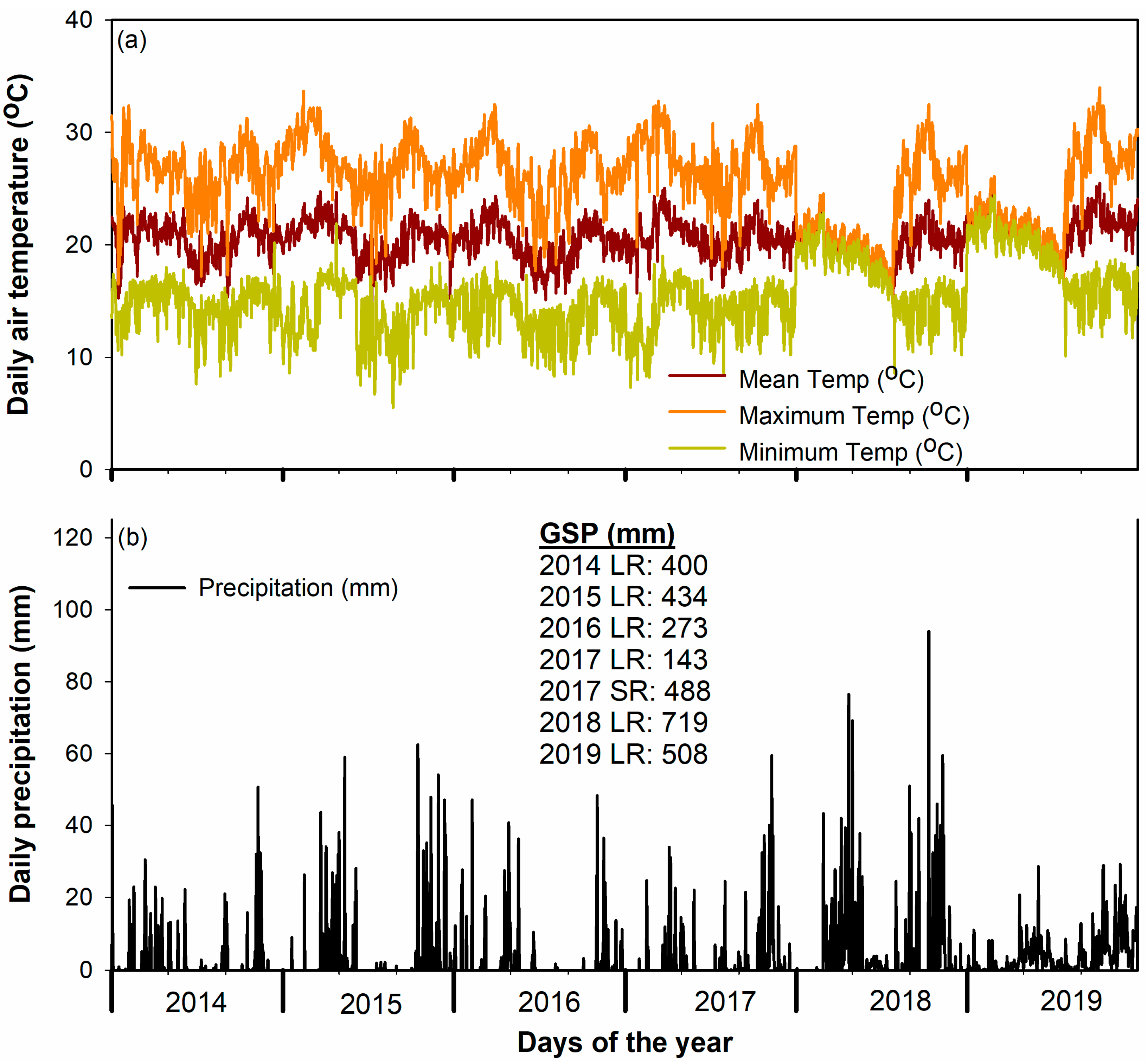




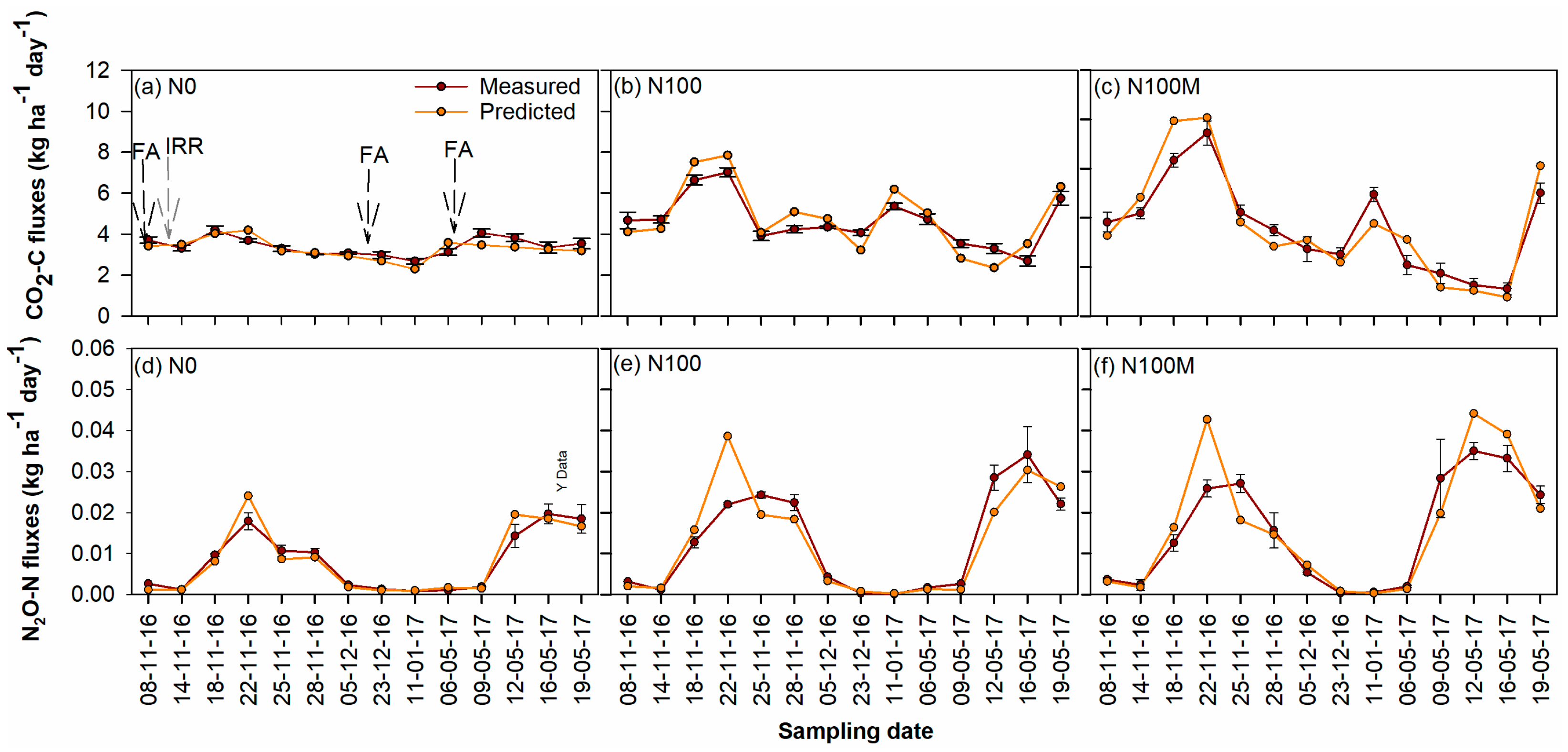
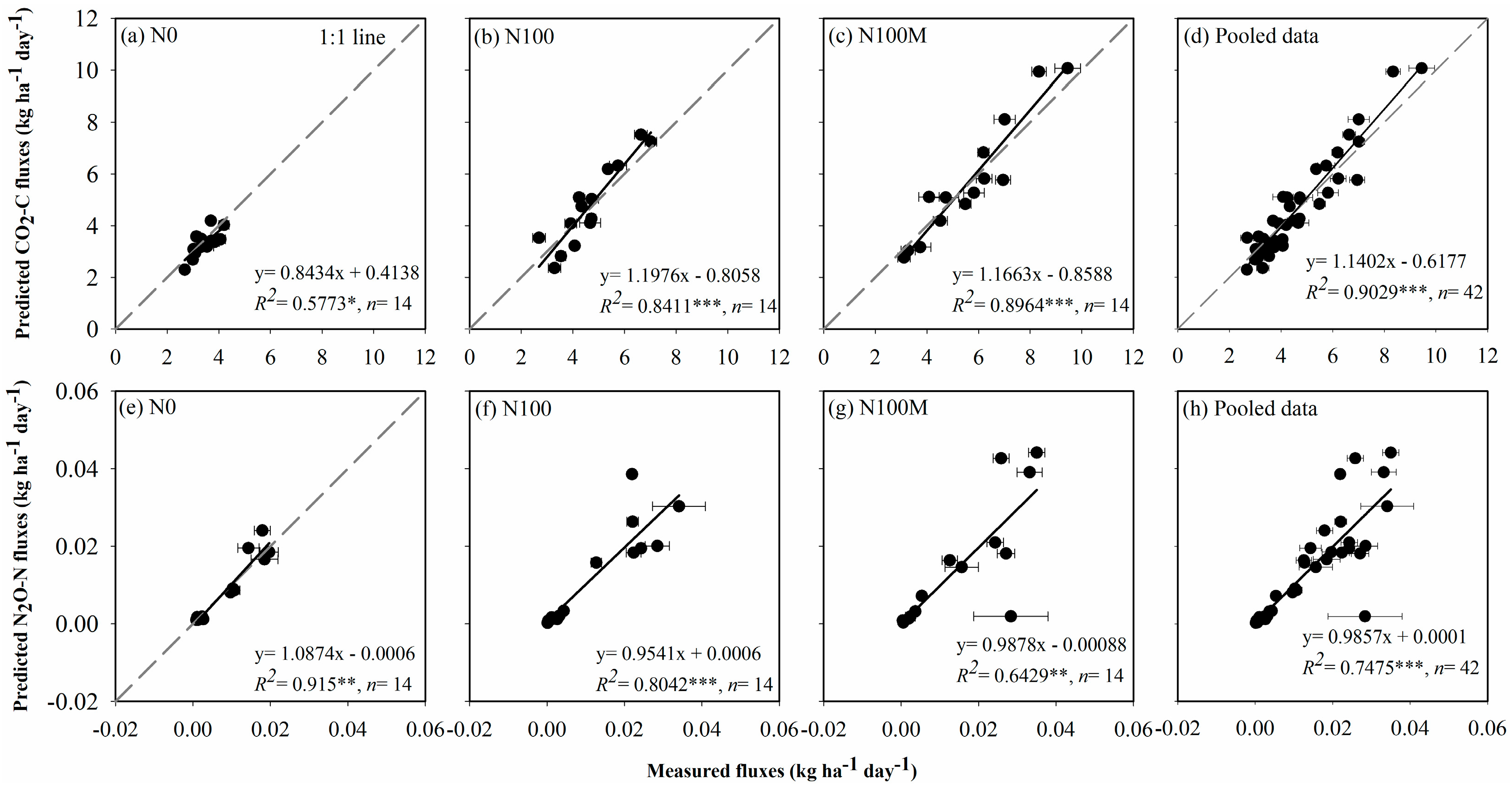
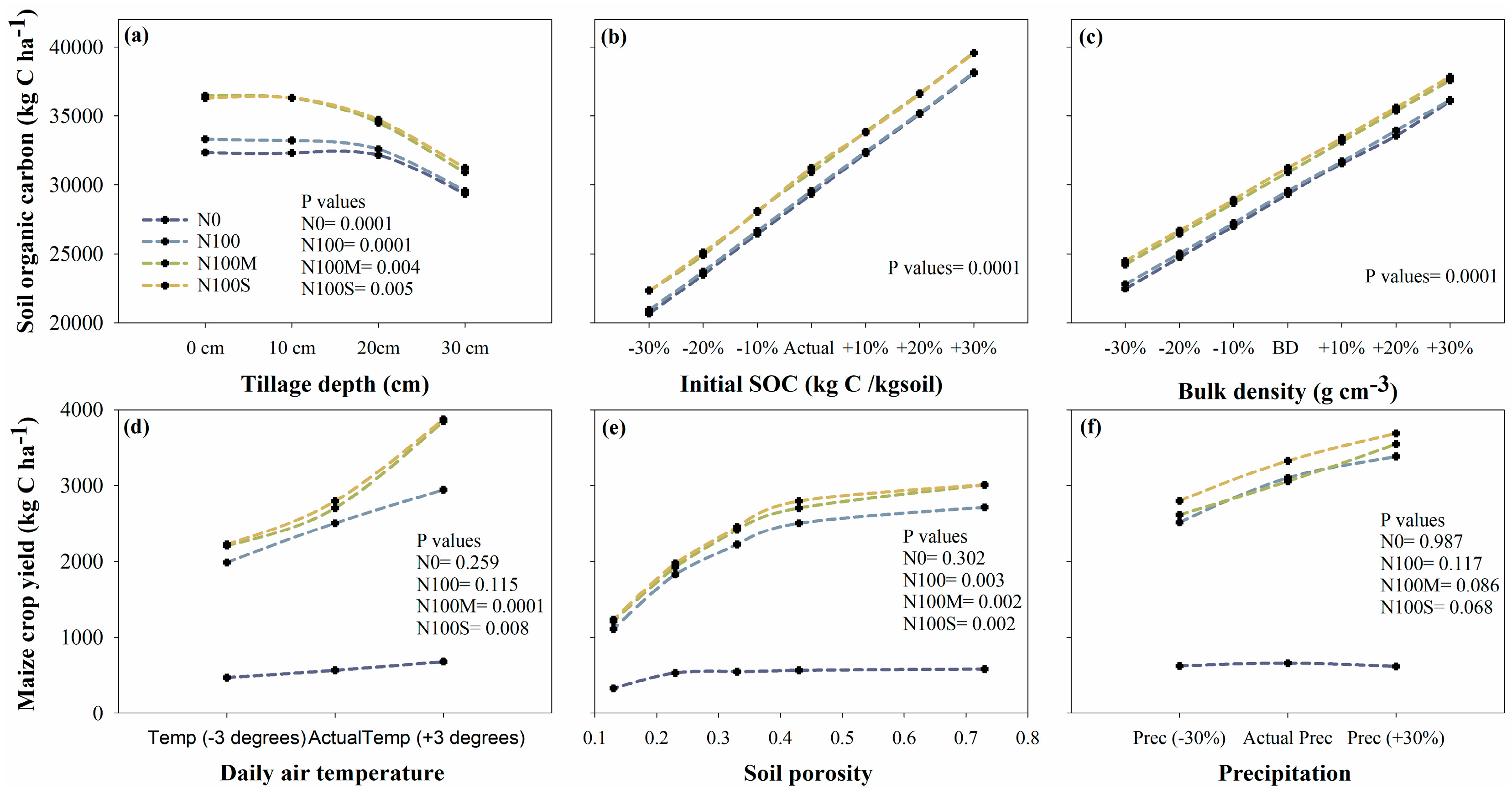

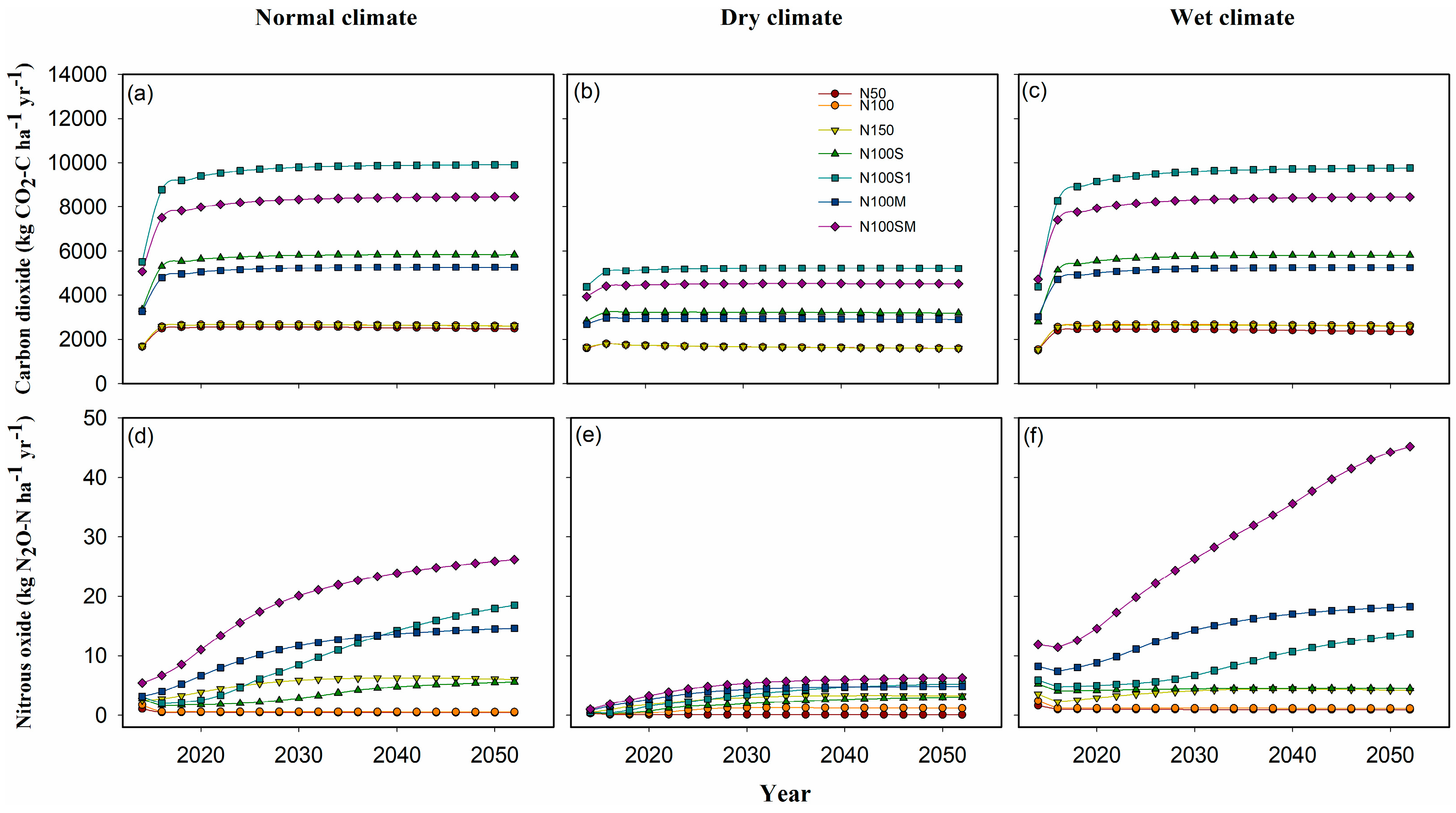
| Season Sequence | Year | Rainy Season | Crop | Tillage Date | Planting Date | Row Space (cm) | Harvest Date | N0 | N50 | N100 | N100M | N150 | N100S | ||
|---|---|---|---|---|---|---|---|---|---|---|---|---|---|---|---|
| Fertilizer | Fertilizer | Fertilizer | Fertilizer | Manure | Fertilizer | Fertilizer | Straw Residue | ||||||||
| (Kg N ha−1) | |||||||||||||||
| 1 | 2014 | Long rains | Maize | 29-March- 14 | 31-March- 14 | 70 | 30-July- 14 | 0 | 50 | 100 | 100 | 60 | 150 | 100 | 25 |
| 2 | 2015 | Long rains | Maize | 8-April- 15 | 9-April- 15 | 70 | 20-July- 15 | 0 | 50 | 100 | 100 | 60 | 150 | 100 | 25 |
| 3 | 2016 | Long rains | Maize | 2-April- 16 | 4-April- 16 | 70 | 17-August- 16 | 0 | 50 | 100 | 100 | 60 | 150 | 100 | 25 |
| 4 | 2017 | Long rains | Maize | 19-March- 17 | 22-April- 17 | 70 | 12-September- 17 | 0 | 50 | 100 | 100 | 60 | 150 | 100 | 25 |
| 5 | 2017 | Short rains | Maize | 31-October- 17 | 2-November- 17 | 70 | 27-March- 18 | 0 | 50 | 100 | 100 | 60 | 150 | 100 | 25 |
| 6 | 2018 | Long rains | Maize | 2-April- 18 | 5-April- 18 | 70 | 8-August- 18 | 0 | 50 | 100 | 100 | 60 | 150 | 100 | 25 |
| 7 | 2019 | Long rains | Maize | 15-April- 19 | 18-April- 19 | 70 | 12-August- 19 | 0 | 50 | 100 | 100 | 60 | 150 | 100 | 25 |
| Parameter | Value/Unit |
|---|---|
| Climatic | |
| Latitude | 1.05 |
| Climate files | Observed data from weather station |
| Climate files format | Jday, MaxT, MinT, radiation |
| All other weather parameters | DNDC default values |
| Soil parameters | |
| Land use | Upland crop field |
| Crop | Maize (DKC 9089) |
| Soil texture | Clay (clay 62.9%, silt 13.6%, sand 23.6%) |
| Bulk density | Observed |
| Soil pH | Observed |
| Field capacity | 0.75 |
| Wilting point | 0.45 |
| Porosity | 0.43 |
| Hydrological conductivity | 0.1 |
| Depth of water retention | DNDC default values |
| Drainage efficiency | 1 |
| SOC partitioning (factions of resistant litter, humads, and humus) | DNDC default values |
| CN ratio (of resistant litter, humads, and humus) | DNDC default values |
| Slope | 5 |
| Treatment | SOC (kg C ha−1) | |||||||||||
|---|---|---|---|---|---|---|---|---|---|---|---|---|
| Measured | S.D | Predicted | S.D | Prediction C.V | Sample No. | E | RMSE | nRMSE % | d | EF | Paired t (p) | |
| N0 | 29,238 b | 1951 | 29,350 d | 1766 | 6.0 | 5 | 112 | 727 | 2.5 | 0.95 | 0.83 | 0.77 |
| N50 | 29,547 b | 2044 | 29,574 c | 1668 | 5.6 | 5 | 27 | 797 | 2.7 | 0.94 | 0.81 | 0.95 |
| N100 | 29,956 b | 1581 | 29,569 c | 1671 | 5.6 | 5 | 388 | 623 | 2.1 | 0.95 | 0.83 | 0.19 |
| N150 | 29,588 b | 2038 | 29,532 c | 1690 | 5.7 | 5 | −56 | 834 | 2.8 | 0.93 | 0.79 | 0.90 |
| N100M | 30,982 a | 1002 | 30,923 b | 963 | 3.1 | 5 | −59 | 355 | 1.1 | 0.96 | 0.84 | 0.75 |
| N100S | 31,183 a | 991 | 31,253 a | 807 | 2.6 | 5 | 70 | 388 | 1.2 | 0.94 | 0.81 | 0.73 |
| Pooled data | 30,082 | 1691 | 30,033 | 1550 | 5.2 | 30 | −49 | 649 | 2.2 | 0.9999 | 0.9995 | 0.69 |
| Treatment | Yield (kg C ha−1) | |||||||||||
| N0 | 780 b | 177 | 564 c | 234 | 41.4 | 6 | −216 | 284 | 36.4 | 0.48 | −2.11 | 0.05 |
| N50 | 1471 b | 702 | 1455 b | 605 | 41.6 | 6 | −16 | 229 | 15.5 | 0.96 | 0.87 | 0.88 |
| N100 | 2565 a | 744 | 2505 a | 557 | 22.2 | 6 | −60 | 265 | 10.3 | 0.95 | 0.85 | 0.62 |
| N150 | 2501 a | 623 | 2606 a | 500 | 19.2 | 6 | 105 | 243 | 9.7 | 0.94 | 0.82 | 0.33 |
| N100M | 2640 a | 624 | 2704 a | 454 | 16.8 | 6 | 64 | 333 | 12.6 | 0.88 | 0.66 | 0.68 |
| N100S | 2769 a | 583 | 2795 a | 548 | 19.6 | 6 | 25 | 178 | 6.4 | 0.97 | 0.89 | 0.76 |
| Pooled data | 2121 | 933 | 2105 | 951 | 45.2 | 36 | −16 | 260 | 12.2 | 0.997 | 0.987 | 0.71 |
| Treatment | CO2-C Fluxes (kg C ha−1 day−1) | |||||||||||
|---|---|---|---|---|---|---|---|---|---|---|---|---|
| Measured | S.D | Predicted | S.D | Prediction CV | Sample No. | E | RMSE | nRMSE % | d | EF | Paired t (p) | |
| N0 | 3.42 b | 0.44 | 3.30 b | 0.49 | 14.7 | 14 | −0.12 | 0.333 | 9.6 | 0.997 | 0.99 | 0.18 |
| N100 | 4.64 a | 1.22 | 4.75 a | 1.59 | 33.5 | 14 | 0.11 | 0.664 | 14.3 | 0.995 | 0.98 | 0.55 |
| N100M | 5.64 a | 1.89 | 5.72 a | 2.32 | 40.6 | 14 | 0.08 | 0.786 | 13.9 | 0.995 | 0.98 | 0.72 |
| Pooled data | 4.57 | 1.58 | 4.59 | 1.90 | 41.3 | 42 | 0.02 | 0.624 | 13.7 | 0.996 | 0.98 | 0.82 |
| Treatment | N2O-N Fluxes (kg N ha−1 day−1) | |||||||||||
| N0 | 0.008 a | 0.007 | 0.008 a | 0.008 | 101.6 | 14 | 0.00010 | 0.002 | 29.9 | 0.988 | 0.95 | 0.88 |
| N100 | 0.013 a | 0.012 | 0.013 a | 0.013 | 101.4 | 14 | −0.00001 | 0.006 | 43.4 | 0.975 | 0.90 | 1.00 |
| N100M | 0.015 a | 0.013 | 0.015 a | 0.016 | 106.3 | 14 | −0.00028 | 0.009 | 60.2 | 0.949 | 0.79 | 0.92 |
| Pooled data | 0.012 | 0.011 | 0.012 | 0.013 | 107.2 | 42 | −0.00006 | 0.006 | 53.0 | 1.046 | 0.85 | 0.95 |
| Treatment | Surface Application | Incorporated (15 cm) | Incorporated (30 cm) | |
|---|---|---|---|---|
| N100S | 30,395 d | 30,947 d | 30,907 d | |
| SOC (kg C ha−1) | N100M | 30,546 d | 31,569 d | 31,418 d |
| N100S1 | 35,801 bc | 37,058 a | 3641 ab | |
| N100SM | 34,879 c | 36,449 ab | 36,251 ab | |
| N100S | 3238 c | 3135 fg | 3132 g | |
| Yield (kg C ha−1) | N100M | 3188 de | 3159 efg | 3161 ef |
| N100S1 | 3408 a | 3215 cd | 3220 c | |
| N100SM | 3333 b | 3212 cd | 3218 c | |
| N100S | 5691 c | 5574 cd | 5529 cd | |
| CO2 (kg CO2-C ha−1 yr−1) | N100M | 5129 de | 4987 e | 4963 e |
| N100S1 | 9578 a | 9312 a | 9196 a | |
| N100SM | 8180 b | 7931 b | 7863 b | |
| N100S | 3.63 de | 2.8 e | 2.58 e | |
| N2O (kg N2O-N ha−1 yr−1) | N100M | 11.15 b | 11.18 b | 11.15 b |
| N100S1 | 10.29 bc | 7.54 c | 6.86 cd | |
| N100SM | 19.37 a | 18.09 a | 17.67 a |
Disclaimer/Publisher’s Note: The statements, opinions and data contained in all publications are solely those of the individual author(s) and contributor(s) and not of MDPI and/or the editor(s). MDPI and/or the editor(s) disclaim responsibility for any injury to people or property resulting from any ideas, methods, instructions or products referred to in the content. |
© 2025 by the authors. Licensee MDPI, Basel, Switzerland. This article is an open access article distributed under the terms and conditions of the Creative Commons Attribution (CC BY) license (https://creativecommons.org/licenses/by/4.0/).
Share and Cite
Aluoch, S.O.; Raseduzzaman, M.; Li, X.; Li, Z.; Bizimana, F.; Yawen, Z.; Mosongo, P.S.; Mburu, D.M.; Waweru, G.; Dong, W.; et al. Combined Mineral and Organic Fertilizer Application Enhances Soil Organic Carbon and Maize Yield in Semi-Arid Kenya: A DNDC Model-Based Prediction. Agronomy 2025, 15, 346. https://doi.org/10.3390/agronomy15020346
Aluoch SO, Raseduzzaman M, Li X, Li Z, Bizimana F, Yawen Z, Mosongo PS, Mburu DM, Waweru G, Dong W, et al. Combined Mineral and Organic Fertilizer Application Enhances Soil Organic Carbon and Maize Yield in Semi-Arid Kenya: A DNDC Model-Based Prediction. Agronomy. 2025; 15(2):346. https://doi.org/10.3390/agronomy15020346
Chicago/Turabian StyleAluoch, Stephen Okoth, Md Raseduzzaman, Xiaoxin Li, Zhuoting Li, Fiston Bizimana, Zheng Yawen, Peter Semba Mosongo, David M. Mburu, Geofrey Waweru, Wenxu Dong, and et al. 2025. "Combined Mineral and Organic Fertilizer Application Enhances Soil Organic Carbon and Maize Yield in Semi-Arid Kenya: A DNDC Model-Based Prediction" Agronomy 15, no. 2: 346. https://doi.org/10.3390/agronomy15020346
APA StyleAluoch, S. O., Raseduzzaman, M., Li, X., Li, Z., Bizimana, F., Yawen, Z., Mosongo, P. S., Mburu, D. M., Waweru, G., Dong, W., & Hu, C. (2025). Combined Mineral and Organic Fertilizer Application Enhances Soil Organic Carbon and Maize Yield in Semi-Arid Kenya: A DNDC Model-Based Prediction. Agronomy, 15(2), 346. https://doi.org/10.3390/agronomy15020346








